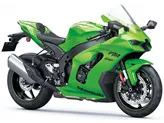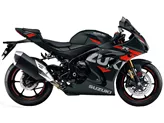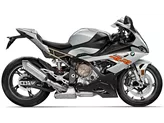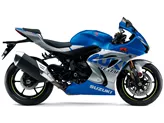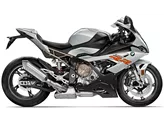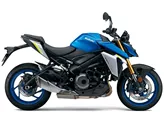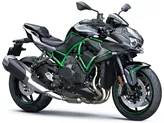Suzuki GSX-R 1000 R 2017 vs. Suzuki GSX-R 1000 2015

Suzuki GSX-R 1000 R 2017

Suzuki GSX-R 1000 2015
Visão geral - Suzuki GSX-R 1000 R 2017 vs Suzuki GSX-R 1000 2015
The Suzuki GSX-R 1000 R 2017 and the Suzuki GSX-R 1000 2015 are both supersport motorcycles from Suzuki, but they have some notable differences in their technical specifications and strengths.
Starting with the technical specifications, both models have an inline four-cylinder engine with a displacement of 999cc. However, the GSX-R 1000 R 2017 has a larger bore of 76mm compared to the 74.5mm bore of the GSX-R 1000 2015. The stroke of the GSX-R 1000 R 2017 is 55.1mm, while the GSX-R 1000 2015 has a stroke of 57.3mm. These differences in bore and stroke contribute to the GSX-R 1000 R 2017 having a higher power output of 202 HP compared to the 185 HP of the GSX-R 1000 2015. The GSX-R 1000 R 2017 also has a higher torque of 118 Nm compared to the 116.7 Nm of the GSX-R 1000 2015. Additionally, the GSX-R 1000 R 2017 has a higher compression ratio of 13.2 compared to the 12.8 compression ratio of the GSX-R 1000 2015.
In terms of suspension, both models feature Showa suspension with adjustable compression, preload, and rebound settings for both the front and rear suspension. This allows riders to fine-tune the suspension to their preferences and riding style.

Suzuki GSX-R 1000 R 2017
Both models have an aluminum frame, but the GSX-R 1000 R 2017 has a dual tube, twin spar frame design, while the GSX-R 1000 2015 has a twin spar frame design. The dual tube design of the GSX-R 1000 R 2017 offers increased rigidity and stability.
In terms of braking, both models have dual disc brakes at the front, but the GSX-R 1000 R 2017 features radial monobloc technology, which provides improved braking performance and feel compared to the radial technology of the GSX-R 1000 2015.
In terms of dimensions and weight, both models have the same tire widths and diameters, with a front tire width of 120mm and a rear tire width of 190mm, both with a diameter of 17 inches. The GSX-R 1000 R 2017 has a slightly longer wheelbase of 1410mm compared to the 1405mm wheelbase of the GSX-R 1000 2015. The seat height of the GSX-R 1000 R 2017 is also slightly higher at 825mm compared to the 810mm seat height of the GSX-R 1000 2015. In terms of weight, the GSX-R 1000 R 2017 weighs slightly less at 203kg compared to the 205kg weight of the GSX-R 1000 2015. Both models have a fuel tank capacity of 17.5 liters.

Suzuki GSX-R 1000 2015
Now, let's compare the strengths and weaknesses of each model. The GSX-R 1000 R 2017 has several strengths, including a high-revving engine, a smooth torque curve, and excellent stability in corners and on fast tracks. It also has an excellent gearbox and a high-quality chassis. On the other hand, it has a non-adjustable engine brake and the wheely control is linked to the traction control, which may limit customization options for some riders.
The GSX-R 1000 2015 has strengths such as sophisticated technology and a wide range of accessories. It also benefits from Suzuki's extensive racing experience. However, it is only available in a gray color option and its electronics are not as up-to-date as the GSX-R 1000 R 2017.
In conclusion, the Suzuki GSX-R 1000 R 2017 offers several improvements over the GSX-R 1000 2015 in terms of power, suspension, frame design, and braking technology. However, the GSX-R 1000 2015 still has its strengths, particularly in terms of its technology and accessories. Ultimately, the choice between the two models will depend on the rider's preferences and priorities.
Especificações técnicas Suzuki GSX-R 1000 R 2017 em comparação com Suzuki GSX-R 1000 2015
Prós e contras em comparação
Prós e contras em comparação
Suzuki GSX-R 1000 R 2017

A Suzuki fez um excelente trabalho com a GSX-R 1000 R 2017. Uma moto potente com uma curva de binário fabulosamente suave. Realmente inacreditável com 202 cv! O chassis é de alta qualidade e o pacote eletrónico não tem qualquer enfeite, mas proporciona um desempenho de topo.
Suzuki GSX-R 1000 2015

Muitos anos de vitórias nas corridas internacionais de motos fizeram da superbike GSX-R1000 uma lenda - e um modelo algo cinzento. As verdadeiras inovações, ou mesmo revoluções, já lá vão há muito tempo e as últimas actualizações limitaram-se a melhoramentos visuais, como o esquema de pintura da réplica de MotoGP. Pode parecer fresca e ágil, mas no segmento das motos de corrida que agora avançaram para motos hiper-desportivas tecnologicamente avançadas e correspondentemente caras, a GSX-R parece agora um protótipo ligeiramente grisalho. Continua a andar bem, rápida e harmoniosamente, mas nota-se que está madura - e isto no sentido positivo. No entanto, já estamos à espera da próxima geração.
Comparação de preços Preço médio de mercado Suzuki GSX-R 1000 R vs Suzuki GSX-R 1000
There are a few key differences between a Suzuki GSX-R 1000 R 2017 and a Suzuki GSX-R 1000 2015. It takes less time to sell a Suzuki GSX-R 1000 with 83 days compared to 176 days for the Suzuki GSX-R 1000 R. Since model year 2017 1000PS.de editors have written 13 reviews for the Suzuki GSX-R 1000 R and 71 reviews for the Suzuki GSX-R 1000 since model year 2005. The first review for the Suzuki GSX-R 1000 R was published on 04/10/2016 and now has more than 197.700 views. This compares to more than 7.100 views for the first review on Suzuki GSX-R 1000 published on 03/03/2004.


